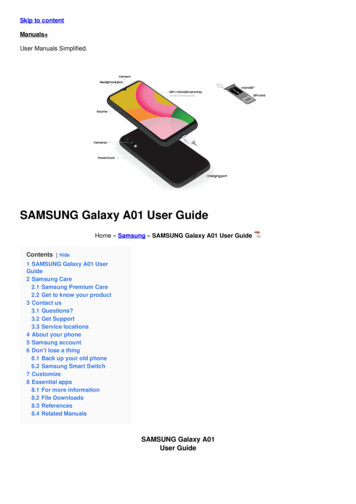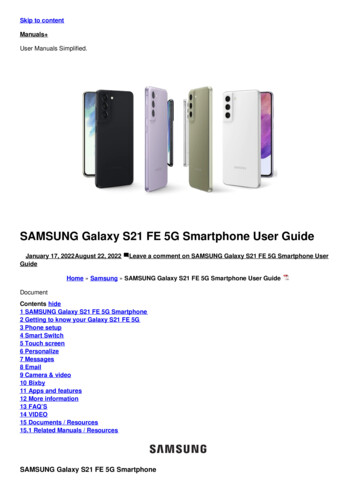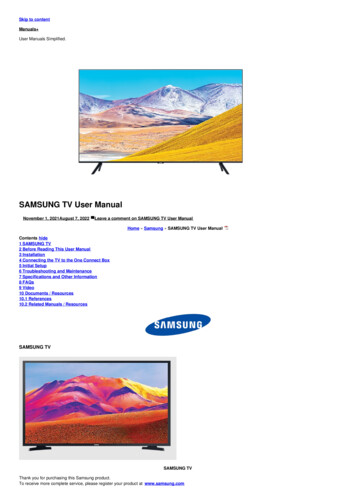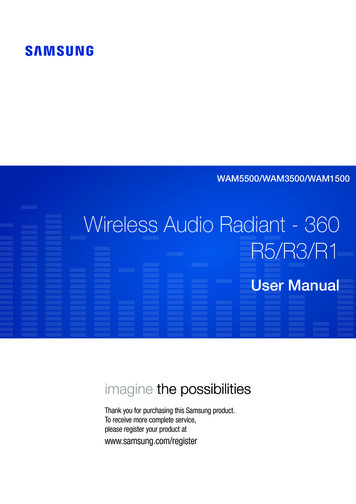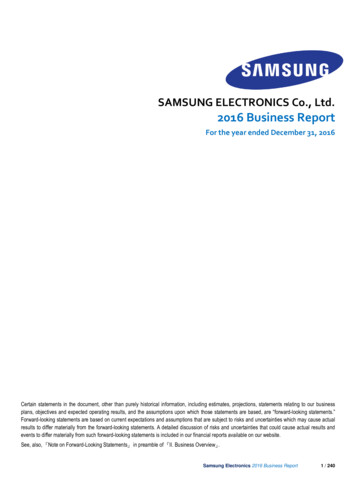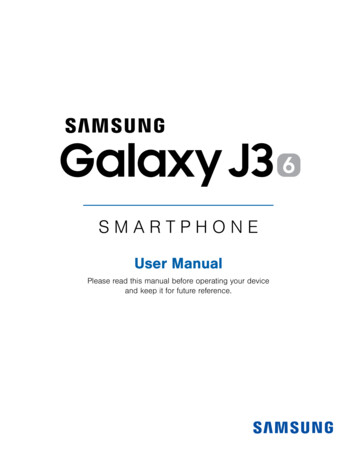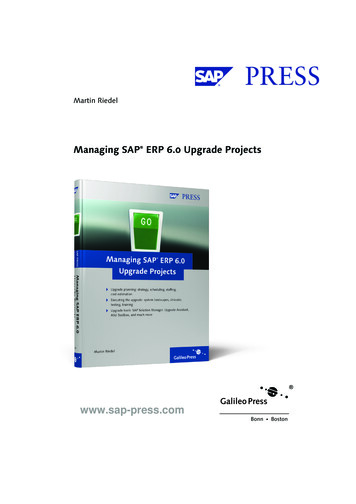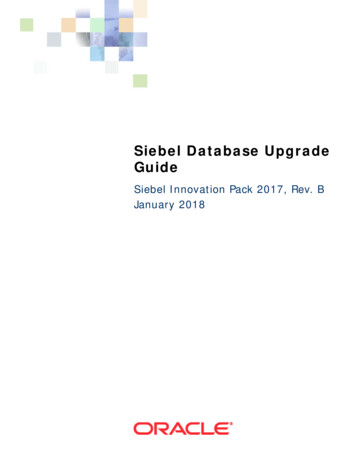
Transcription
Upgrade Your Enterprise withthe SSD that Redefines PerformancePM9A3 SSDWhitepaper
Executive SummaryToday, an explosion of data and an ever-expanding number of computing devices – spanning everything from IoT to 5G-enhanced edgecomputing, to exascale supercomputers – is redefining computing and storage demands.These ongoing trends have wide-ranging ramifications for enterprise computing and web-scale data centers. And with digital servicesexperiencing exponential growth, these trends are expected to continue in the post-pandemic era. This means that now more than ever, theworld needs more powerful data centers, enterprise servers and storage solutions.NAND Solution Market OutlookEnterprise SSD market to see continuing growth due to data explosionSmartphonePC SSDDC / Enterprise SSD[ GB/Sys, YoY ]48%46%5783[ Demand, B GB 0'211,8802,24997(Storage included)512GB 9256GB4131128GB64GB32GB'18'19'20'21'18'19'20'21* Source : Samsung, Forward InsightsWhat’s more, modern server workloads continue to change thanks to an influx of machine-generated unstructured data. These new workloadsneed to be analyzed in real time to facilitate everything from AI-assisted diagnostic imaging to high-frequency stock trading, as well as effortslike banking and credit card fraud detection, and to enable software to make real-time decisions about how best to deliver packages. Solidstate devices are better suited for meeting the storage demands of use cases like these than traditional spinning disks – hard disk drives (HDD).Scalable, high-performance, energy-efficient storage devices must continue to keep pace with the market’s evolving needs. Fortunately, industryinnovations in the form of standards and technologies such as PCIe Gen.4 and our sixth-generation V-NAND are proving equal to the task.Samsung’s state-of-the-art PM9A3 NVMe SSD is a testament to this fact – one that is available in more form factors than any competing SSD.Before discussing the ins and outs of the PM9A3, we’ll begin this paper with a brief history of the SSD industry, along with details on how theindustry has grown and how its products are being used.Technical trend of DC NVMe SSDs From 2020, PCIe Gen.4 based DC NVMe SSDs have been introduced continuously SSD’s own performances are gettinghigher and various types of new formfactors are being adopted to meet hostlevel requirements.Samsung is the leading company to supportbest in class performances and all kinds ofform-factorForm FactorE1.L2020 , PCIe Gen.4E1.S 2019, PCIe Gen.3U.2/U.3M.225050027501000 Ran. Read (KIOPS)
SSD History & Market GrowthA Brief History of SSDsSSD data storage uses integrated circuit assemblies to store data persistently, typically using flash or NAND flash memory. It has beenclose to 50 years since semiconductor researchers began developing the first solid-state drives, which store data on memory chips that arebecoming increasingly faster, more powerful and energy-efficient, as opposed to the spinning magnetic disks used by traditional HDDs.SSDs store data in thousands of tiny memory cells that are arranged on circuit boards. As the “solid-state” in their name suggests, SSDs haveno moving parts, which allows them to be inherently faster than HDDs, as well as smaller, more durable, and more reliable.However, when they were first introduced, SSDs were far too expensive, and initially lacked the storage capacities necessary for widespreaduse. For example, when Storage Technology Corp. introduced what some considered to be the first SSDs to be compatible with IBM mainframecomputers in 1978, the company’s car-engine-sized machines were only capable of storing a meager 45 megabytes (MB) – roughly equivalentto the amount of data involved in 20 average-sized web pages today. On top of that, the exorbitant 400,000 price tag per system scaredaway many potential buyers.By comparison, today, SSD buyers can choose from dozens of offerings with huge, one-terabyte (TB) storage capacities for less than 100.This is reflective of the power of Moore’s Law, which describes how each generation of technology utilizes denser circuitry, resulting in higherperformance, less energy use, and lower cost per MB.Not surprisingly, the SSD market has been growing rapidly as more SSDs replace traditional HDD devices. SSD technology, too, has rapidlyevolved, with storage densities increasing and the price per MB steadily dropping. With the growth of data over the last decade, manyenterprises have been accelerating their transition from HDDs to high-capacity SSDs.SSD Market GrowthThe industry’s overall rate of SSD sales growth has been driven by PCIe performance benefits, as well as increasing densities, improvingperformance, and lowering costs. Last year there was an impressive 22 percent growth in worldwide SSD sales, which rose from 23 billionto 32 billion according to the London-based market researcher firm Omdia. Moreover, in its Worldwide 2020–2024 Enterprise SSD and HDDCombined Market Overview, IDC projects that SSDs will steadily displace performance-optimized HDDs as primary storage in servers andstorage systems.The migration away from HDD technology and toward SSD enables systems to boot faster and load applications quicker, and improves overallsystem responsiveness.SSD technology is now primed to become the leading storage medium for the big data age. Its inherent attributes of scalability, reliability andenergy efficiency make it the premier option for the server market.Industry Interface Trend: NVMe Drives eSSD GrowthPCI ExpressTM performance benefits drive interface conversion and higher density SSD – More than 8/16TBAVG Density TrendeSSD Interface Trend[Unit: AVG IeSATA28%31%20.Q1BlendedAVG All eSSD(AVG 1,1251,1561,1851,21521.Q121.Q221.Q321.Q4(AVG GB/Drive)21.Q221.Q321.Q4* Source : Samsung, Forward Insights320.Q320.Q4
Next-Generation SSDsPM9A3: Gen.4 Drives Dynamic Data TrafficTraditionally, data centers and enterprise storage have represented two separate markets for SSDs. While the former require storagesolutions that are optimized for data center architectures and offer greater efficiency, SSDs for enterprises tend to emphasize special featuresand robust reliability.Samsung’s PM9A3 NVMe SSD offers best-in-class PCIe Gen.4 performance, multiple platform efficiencies, a highly scalable designencompassing several form factors, and greater reliability with advanced V-NAND technology. The SSD is specifically designed for the nextera of servers, both in data centers and for enterprises in general, meets the needs of servers for mainstream use, and is suitable for the web,applications, and file servers.The following table highlights the PM9A3’s advancements and compares them with the previous generation’s enterprise SSD leader, the PCIe Gen.3-based PM983.PM9A3 OverviewPM9A3PM983InterfacePCIe 4.0 x 4PCIe 3.0 x 4ControllerElpis (8ch)Phoenix (8ch)NANDV6 TLCV4 TLCForm-FactorU.2, U.3, M.2, E1.S, E1.LM.2, B/3.84TB/1.92TB/960GBLogical Block Address512B(Default), 4KB512B(Default), 4KB1.4(Mandatory Only)1.3cNVMe versionNVMe SanitizeSpecificationDevice Self TestNVMe 1.3 Compliance(Block Erase, Crypto Erase)Not SupportSupportNot SupportSEDTCG/OpalTCG/OpalDrive Writes per Day1@5 years1.3@3 years4
Open Compute Project Meets Open Compute Project SpecificationThe new PM9A3 fully complies with the Open Compute Project ’s (OCP) NVMe Cloud SSD Specification, which proves that it satisfies therigorous demands of enterprise workloads and hyperscalers. This includes an emphasis on efficient, scalable operations and support, alongwith commitments to open source and to creating a positive impact.EFFICIENCYSCALABILITY All OCP contributions must have an efficient design some examples of efficiencymay be- power delivery and conversion- thermal efficiency- platform performance(per-W for example)- reduction in overall infrastructure costs- reduction in code weight- reduction in latencies All OCP contributions must be scalable. This means that the technology isdesigned with the right supporting features to allow for its maintenance in largescale deployments. This may include:- physical maintenance- remote management- upgradability- error reporting- maintenance service (remote or onpremise) Management tools should be open-sourced or made available to adopters Supporting documentation for each contribution should enable adopters towards- installation guidance- initialization process- configuration information- how to obtain service supportOPENNESSIMPACT All OCP contributions must be open. This encourages as much open sourcecontribution as possible. OCP understands that in certain cases 100% opensource contribution may not be possible All OCP contributions must create meaningful positive impact within the OCPecosystem. This may be attained by the introduction of:- efficiency gains- utilization of new technologies- products that are valuable for scale out computing, creating a multiplier effectby building on top of already existing OCP solutions- enabling a more robust supply chain by contributing alternative compatiblesolutions Whether fully open source or not, a contribution should strive to comply with aset of already existing open interfaces, at the very least be able to provide one Providing a solution compatible with already existing OCP contributions is oneway to implement existing(open) interfaces* Source: 2-1.pdfDesign Capability: New Reference design based on OCP specsSamsung is the leading company to provide server and datacenter system designers’ capability. PM9A3 fully implements OCP’s specification(Poseidon project) Offering the most 1U server-optimized form-factor, the PM9A3 will improve spaceutilization, add PCIe Gen.4 speeds, enable increased capacity and moreOCP based 3-way PartnershipPoseidon SWPoseidon HWOpen-source StorageOS for NVMe FPCIe Gen.4 E1.S SSDRef. SystemTremendous Performance in Storage SystemPM9A3 delivers up to 6,950 MB/s in sequential read speed with form factorflexibilitySequentialReadPM983a3,100 MB/sPM9A36,950 MB/sPowerEfficiencyPM983a188 MB/s Per wattPM9A3283 MB/s Per watt* Source : tion-through-the-open-compute-project/5 3,850 95
Open Compute Project Recently, the OCP Foundation recognized the PM9A3 as an OCP InspiredTM product. The OCP InspiredTM certification attests that the PM9A3has been formally reviewed by the OCP Foundation and meets the approved specification. Beginning in the third quarter of 2021, the OCPFoundation will provide a marketplace that offers major server manufacturers, as well as general customers such as SMBs (small andmedium-sized businesses) access to channels that will enable them to purchase Samsung SSDs.Design Capability: New Reference design based on OCP specsThe OCP foundation recognizes PM9A3 as OCP InspiredTMproduct Customers easily can reach out Samsung SSD PM9A3 through OCP Marketplace from 3Q* Source : https://www.opencompute.org/products6
PCIe Gen.4 PerformanceIndustry-Leading PCIe Gen.4 PerformanceThe bandwidth of PCIe Gen.4 is twice that of the prior Gen.3 interface, which means that the new PCIe Gen.4-based PM9A3 offers greaterthroughput and higher performance than competing PCIe data center SSDs.The PM9A3 also leverages Samsung’s technological know-how to deliver enormous performance gains across sequential and randomoperations. With random write performance being one of the most important factors when designing servers, the PM9A3 enables 200,000IOPS random writes, and features hardware automation technology to further enhance random write performance.PCIe Gen.4 PerformancePM9A3 provides best-in class PCIe Gen.4 performance for all kinds of form-factor Random write performance is the key performance of PM9A3.Even though high performance, PM9A3 consumes small amount of power for datacenters’ power efficiencyForm FactorU.2 (2.5”mm 80800800550Write20018013070858560Active 7.5/6.5Idle3.53.53.53.52.52.52.5Sequential(128KB, MB/s)Random(4KB, KIOPS)Power(Watt)M.2 (22x110mm)* Performances of E1.S, E1.L and U.3 form-factor are similar to U.2 based products and are providing to contracted and selected OEM companies For processing this project,Samsung will not provide detail numbers.PM9A3 offers better IOPS consistencythan market alternatives. An SSD’sperformance is generally governed byPM9A3 shows better stable IOPS consistency with higher performance4KB Ran.Read[KIOPS]1200controller channels – the physical paths1000through which data is bidirectionally800transferred between the controller andthe NAND.One might expect that SSDs witheight channels tend to be more powerefficient and cheaper than those with16 channels or more. However, thanksto Samsung’s know-how and hardwareautomation, the eight-channel PM9A3has been optimized for system-levelintegration, and manages to provideconsistent or better performance 633225328733493411347335353597industry-leading performance, the[sec]4KB 4813541Moreover, in addition to of feringcompeting 16-channel SSDs.[sec]7
PCIe Gen.4 Performance4KB Ran. Performance of 3.84TB varying workload patten compared toone of competing 16-channel based SSD.PM9A3 provides robust 4KB Ran. performance in various types of mixed workload patternDatacenter customers are usually focusing on 70% Read case(mixed workload 7:3), PM9A3 shows up to 20% higher IOPS.PM9A3ARead portion 100%[KIOPS]Read/Write portion Write portion d/Write portion D16QD32QD1Write portion 6QD328QD2QD4QD8QD16QD32QD8
PCIe Gen.4 PerformanceIn addition, when managing mixed workloads, the PM9A3 offers significantly better random read/write performance than conventionaleight-channel SSDs.PM9A3 provides robust 4KB Ran. performances in various types of mixed workload patternDatacenter customers are usually focusing on 70% Read case(mixed workload 7:3), PM9A3 shows up to 27% higher IOPSPM9A3 1.92TBB 1.92TBRead portion 100%[KIOPS]Read/Write portion rite portion te portion D1Write portion 6
PCIe Gen.4 PerformanceThe PM9A3’s random average latency scores, too, are consistent and competitive when managing various workloads, while its random writelatency scores routinely exceed those of conventional PCIe Gen.4 SSDs. In quality of service (QoS), an important measurement of SSDperformance, the PM9A3 offers an average latency that’s consistently more stable across various QoS workloads. Providing significantlylower QoS at 99.99 percent, the PM9A3 is capable of enhancing host systems with robust stability.4KB QoS 99.99%(ms) of 3.84TB varying workload pattenPM9A3 provides much lower QoS in 99.99%, it can provide robust stability for host systemRead portion 100%[ms]Read/Write portion 70%/30% 16QD32QD64QD128QD256QD1Read/Write portion 70%/30% Write[ms]QD2QD8QD16QD32QD64QD128QD256Read/Write portion 50%/50% QD8QD16QD32QD64QD128QD256QD1Read/Write portion 50%/50% Write[ms]QD2QD8QD16QD32QD64QD128QD256Read/Write portion 30%/70% QD8QD16QD32QD64QD128QD256QD1Read/Write portion 30%/70% D256Write portion D32QD64QD128QD1QD25610QD2QD4QD8QD16QD32
Multiple Form FactorA Form Factor for Every NeedSamsung’s PCIe Gen.4 NVMe SSD portfolio is the most robust in the market, and includes five different form factors – U.2, U.3, M.2, E1.S,E1.L – of various widths and lengths. This adds flexibility to installations and enables the SSDs to meet virtually any server requirements.Capacities range from 960GB at the lower end to 15.36TB for U.2 – more than double the capacities of earlier technologies. The M.2 versionoffers up to 3.84TB of storage capacity, while the E1.S model provides up to 7.68TB of storage space.Design Capability: Multiple Form FactorSamsung can meet various form-factor needsfrom server manufacturers and DC architecturedesigners – M.2, U.2, E1.S, E1.L and U.3M.2U.2E1.SSSD Form factors"Form factor" refers to the size and physical configuration of a device. At first, server manufacturers needed to standardize storages’ dimensions for their systems’ design As much higher capacities are needed, F/F has become as constraints for scalability, so many new F/Fs have been introduced to meet new demands ofserver market, for example, high capacity servers and new interface for better performanceU.2E1.SE1.LE3.S/E3.LM.2Dimension (WxL, mm)69.85 x 100.233.6 x 118.75 (Others)38.4 x 318.7576 x 113 (Short)76 x 142 (Long)22 x 110ConnectorSFF-8639Max pOOOOXDual-PortOOOOXMax. Capacity32TB16TB32TB32TB4TB444/84/8/164 Number of PCIe LaneM.2 Connector11
The New Height of Dynamic SpeedUncompromising PerformanceUnlike other PCIe Gen. 4 SSDs, which can face compatibility issues when utilized with previous-generation servers, the PM9A3 offers superiorwrite speeds even when paired with PCIe Gen. 3 servers. This increase is especially impressive when it comes to random writes, and can beattributed to PCIe Gen. 4’s enhanced performance. The results are a sequential write speed of 3,500MB/s, a random read speed of 800,000IOPS, and a random write speed of 200,000 IOPS.PCIe Gen.3 Sequential PerformancePM9A3 shows up to 1.3x times faster Seq. Write than its previous generation PM983 with PCIe Gen.3 Interface. Improvements of read performances around 10% are not outstanding than write due to PCIe Gen.3 interface 3,0002,8092,1582,1612,1257.68TBSeq. Write (MB/s)3,584Seq. Read (MB/s)3,5843,5023,575Seq. Write (MB/s)3,4493,5863,4483,5763,3513,5833,192Seq. Read 2TB960TBM.2PCIe Gen.3 Random PerformancePM9A3 shows up to 3.6x times better Ran. Write than its previous generation PM983 with PCIe Gen.3 Interface due to improved V6 NAND. For the case of Ran. Read, PM983 provides up to 48% better than PM983 NAND characteristics affects random performances directly compared to seq. performances V6 NAND speed is 33% faster than V4, PM983 is based on V4 5207861849851M.2 Ran. Write (KIOPS)104M.2 Ran. Read (KIOPS)104U.2 Ran. Write (KIOPS)819U.2 Ran. Read 21.92TB960TB
Energy-Efficient OperationRaising performance expectations with efficient power managementThe PM9A3 features Samsung’s sixth-generation, 128-layer V-NAND, which offers up to 10 percent lower latency and consumes 15 percentless power than the company's previous-generation V-NAND(96 Layer, V5). The SSD also boasts a power efficiency of 238MB per second perwatt for sequential writes – a 50 percent improvement over its predecessor – which improves the power efficiency of data center operations.Power EfficiencyRegardless PCIe version, PM9A3 provides the lowest power consumption with the fastest performances.Lower power consumption is the key factor of TCO for datacenters. Lower power means lower heat generation and it directly affects cooling cost of systems and datacenters12V supply conditionCapacityActive(Watt)U.2 (2.5”, 7mmT)M.2 3.53.53.52.52.52.5Idle (Watt)Form Factor Max Power25W (Watt)8.25W (Watt)1) Power consumption was measured in the 12V power pins of the connector plug in SSD. The active and idle power is defined as the highest averaged power value, which is the maximum RMS average value over 100 ms duration.2) The measurement condition for active power is assumed for Maximum power between sequential or random performance in PCIe Gen.43) The idle state is defined as the state that the host system can issue any commands into SSD at any timeU.2 Seq. Read (MB/s per Watt)Efficient Power ManagementSeq. ReadPM9A3 provides up to 1.8x times betterpower efficiency than previous generation,PM983 Even though PM9A3 is PCIe Gen.4based SSD, less power consumptionwith higher performancePM9A3PM983Efficient Power ManagementSeq. WritePM9A3 provides up to 1.6x timesbetter power efficiency than previousgeneration680627609M.2 Seq. Read(MB/s per .2 Seq. Write (MB/s per Watt)3.84TB3951.92TB400960TBM.2 Seq. Write (MB/s per 0TBOf course, a key part of maximizing the efficiency of enterprise and data center servers involves correcting errors quickly when issues arise.The PM9A3’s Samsung Debug technology enables IT administrators to do just that. Based on NVMe telemetry, this convenient featureoffers a basic diagnosis of a system’s status, and allows log data from failed drives to be sent to Samsung remotely to produce in-depth failureanalysis (FA) reports.13
Real-World BenefitsOptimal for Enterprise WorkloadsUtilizing simulated tests, Samsung’s PM9A3 outperformed market alternatives across multiple workloads, including a web server and anexchange email sever.11) Workloads in test scripts featured 4KB transfer size with 100% access, 8KB-aligned on I/Os.User-environment simulation testWeb ServerUser-environment simulation testExchange email* Higher is A33.84TBPM9A31.92TBB1.92TB4KBWeb Server4KBExchange emailSeq. Read25%Seq. Read0%Seq. Write75%Seq. Write100%Ran. Read95%Ran. Read67%Ran. Write5%Ran. Write33%14
Real-World BenefitsUsing a use case with a MongoDB application measured through the Yahoo Cloud Service Benchmark (YCSB), the PM9A3 completed the testin up to 32 percent less time and delivered nearly 25 percent greater throughput when compared to an alternative PCIe Gen.4 SSD.Real world example: MongoDB YCSB (Yahoo Cloud Service Benchmark)Samsung ran a real-world application to demonstrate the excellence of PM9A3 when running mixed workloads MongoDB is one of the most popular database management systems YCSB is a database benchmark widely used to access cloud service quality, and can be applied to various databases such as AWS S3, Aerospike, Cassandra, and so onTest environments and scenario3.84TBWorkload ARead/Update 50/50Workload ARead/Update 50/50Thread : 16Record : 300,000,000*Operation : 20,000,000,000Thread : 16Record : 300,000,000Operation : 20,000,000,000MongoDBMongoDBYCSBCentOS 8Hardware :Dell R6525 /EPYC 7452 32-Core*2-Socket (64-cores)32GB MemoryHardwarePM9A33.84TBTest environments and scenario1.92TBYCSBCentOS 8HardwareA Drive3.84TBWorkload ARead/Update 50/50Workload ARead/Update 50/50Thread : 16Record : 300,000,000*Operation : 20,000,000,000Thread : 16Record : 300,000,000Operation : 20,000,000,000MongoDBMongoDBYCSBCentOS 8Hardware :Dell R6525 /EPYC 7452 32-Core*2-Socket (64-cores)32GB MemoryHardwarePM9A31.92TBYCSBCentOS 8HardwareB Drive1.92TB* 300M record counts equal to 390GB amounts of data, operation counts 2 Billion consist of Read operation 1B and update 1B.15
Real-World BenefitsReal world example: MongoDB YCSB (Yahoo Cloud Service Benchmark)PM9A3 shows 32% time saving and 25% more data operation in 3.84TB case Even though 8x based PM9A3 (lower datasheet performance), it provides much less runtime and more DB throughputPM9A3A DriveRuntime (min)2,468 (41hr 08min)3,266 (54hr 43min)DB Throughput (ops)13,50210,203Read Avg.1,1541,535th2,4913,381Update Avg.1,2111,597th2,5873,511Latency(ms)Read 99Update 99Run Time(min)DB Throughput(ops)* Loweris better32%* Higheris better3,26613,50224%2,468PM9A3 3.84TB10,203A 3.84TBRead-99Update-99read-99 (ms)update-99 1001502002500300050100time (600s)150200250300PM9A3APM9A3Atime (600s)PM9A3 shows around 10% better performances in 1.92TB Most of all, aside from time and throughput, PM9A3 provides much more stable latency during operationsPM9A3B DriveRuntime (min)2,674 (44hr 34min)3,009 (50hr 09min)DB Throughput (ops)12,46311,077Read Avg.1,2481,408th2,7913,797Latency(ms)Read 99Update Avg.1,3151,475th2,9454,163Update 99PM9A3 0050* Loweris better13%* Higheris better3,00911%12,4632,67411,077Update-99update-99 (ms)0DB Throughput(ops)B 2TBread-99 (ms)0Run Time(min)1001502002503000050time (600s)100150200250time (600s)* Run Time is much shorter than compared drive under same test condition.16300PM9A3BPM9A3B
ConclusionWith an optimal mix of performance, reliability, design capability – thanks to a variety of available form factors – and energy-efficiency, theSamsung PM9A3 offers the industry’s broadest and most capable lineup of enterprise and data center SSDs.Combining PCIe Gen.4 with optimal performance for mainstream (computing and storage) NVMe servers, the new SSDs are highly reliable,offering best-in-class QoS for various workloads. They offer improved energy efficiency, as well as enhanced design scalability under hostlevel constraints, including 1U servers, providing multiple form factors to meet various design needs.The SSDs also adhere to the OCP’s NVMe Cloud SSD Specification, which includes a new OCP reference design, and are recipients of the OCPInspiredTM certification. The advantages of the devices have been demonstrated through user environment simulations across a variety of usecases, as well as through a real-world test that utilized a MongoDB application and was measured by the Yahoo Cloud Service Benchmark.Specifically designed for the next era of servers, the PM9A3 combines best-in-class SSD attributes to enable enterprises to become moreagile, scalable and performant, and significantly more efficient.※ Evaluation results may vary depending on the server environment and settings.Performance measurements are based on fio 3.3. Performance may vary based on SSD’s firmware version,system hardware & configuration.Test system configuration: AMD X570, DDR4 16GB, and CentOS 7.6 with Kernel 4.15 / Physical.※ In this paper, 1TB means 1012 Bytes by IDEMA.Legal DisclaimerSAMSUNG ELECTRONICS RESERVES THE RIGHT TO CHANGE PRODUCTS, INFORMATION AND SPECIFICATIONS WITHOUT NOTICE.Products and specifications discussed herein are for reference purposes only. All information discussed herein is provided on an "AS IS" basis, withoutwarranties of any kind. This document and all information discussed herein remain the sole and exclusive property of Samsung Electronics. No licenseof any patent, copyright, mask work, trademark or any other intellectual property right is granted by one party to the other party under this document,by implication, estoppel or otherwise. Samsung products are not intended for use in life support, critical care, medical, safety equipment, or similarapplications where product failure could result in loss of life or personal or physical harm, or any military or defense application, or any governmentalprocurement to which special terms or provisions may apply.For updates or additional information about Samsung products, contact your nearest Samsung office.About Samsung Electronics Co., Ltd.Samsung inspires the world and shapes the future with transformative ideas and technologies. The company is redefining the worlds of TVs,smartphones, wearable devices, tablets, digital appliances, network systems, and memory, system LSI, foundry, and LED solutions. For the latest news,please visit the Samsung Newsroom at news.samsung.com.Copyright 2021 Samsung Electronics Co., Ltd. All rights reserved. Samsung is a registered trademark of Samsung Electronics Co., Ltd. Specifications and designs are subject tochange without notice. Nonmetric weights and measurements are approximate. All data were deemed correct at time of creation. Samsung is not liable for errors or omissions. Allbrand, product, service names and logos are trademarks and/or registered trademarks of their respective owners and are hereby recognized and acknowledged.Samsung Electronics Co., Ltd.129
The OCP Inspired TM certification attests that the PM9A3 has been formally reviewed by the OCP Foundation and meets the approved specification. Beginning in the third quarter of 2021, the OCP Foundation will provide a marketplace that offers major server manufacturers, as well as general customers such as SMBs (small and


